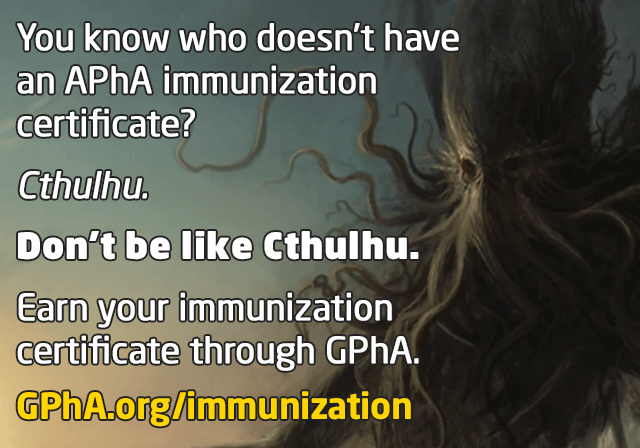Human lifespan explained, apnea drug treatment, better antivirals, and more
15 Apr 2022
Posted by Andrew Kantor
A drug for sleep apnea?
CPAP, schmeepap — carbonic anhydrase inhibitors (e.g., sulthiame) can reduce the number of times someone with sleep apnea stops breathing during the night, thanks to the way carbonic anhydrase helps the body balance carbonic acid and carbon dioxide.
Swedish researchers found that…
Compared to before receiving the treatment, breathing pauses decreased with on average more than 20 per hour for patients given the drug.
And for 20 percent of the patients, “the number fell by at least 60 percent.” The best part is that, because these drugs are already approved for other uses, further testing will be quick.
The call of training
Luckily, GPhA is offering that very “APhA’s Pharmacy-Based Immunization Delivery: A Certificate Program for Pharmacists” in about a month: Sunday, May 22 from 8:00 am – 5:00 pm at GPhA’s World Headquarters in Sandy Springs. Time to register and prepare.
Note: This is always a popular course, so sign up quick so you are aren’t left out and embarrassed to show your face at the convention. Get to GPhA.org/immunization for the details and to register!
Severe Covid could get a med
Sabizabulin: Not just an 11th century Islamic mathematician, but also a new drug whose maker claims it cut deaths of seriously ill Covid patients in half.
If trials bear this out, it’s a big deal because there aren’t treatments for the critically ill. (Antivirals like Paxlovid keep people out of the hospital; they’re not helpful for the seriously sick.)
“Sabizabulin is the first drug to demonstrate a clinically and statistically meaningful reduction in deaths in hospitalized patients. This represents a big step forward.”
So says the CEO of the company that makes it, and kudos to him for not calling it a “game-changer.”
Speaking of antivirals….
A new one — a nasal spray — might be a better option than pills or an IV. Human trials are coming soon, but it works in mice, so that’s something. The best part isn’t just that it (seems to) work better than existing antivirals, but that it works on every Covid-19 variant.
By blocking the virus’ spike protein, the new antiviral prevents it from binding to the human [ACE2] receptor, which is the entry point for infecting the body. Because the novel coronavirus and its mutant variants cannot infect the body without binding to the ACE2 receptor, the antiviral also should work against future variants.
Where techs can cash in
Hey, pharmacy techs — wondering what city has the best pay? Wonder no more: In Georgia, it’s Hinesville*, with an average technician salary of $37,980. (Forbes has the full list for every state, from Ann Arbor and Billings to Topeka and Trenton.)
* Home of the ITPA National Telephone Museum
Old med, new anti-anxiety treatment?
Disulfiram, which is normally used to treat alcoholism, might also be a good anti-anxiety drug. Japanese researchers, wondering how it effect on chemokine receptors might affect stress level (after all, it is regulating emotions, in a sense) tested it on mice.
They found that mice treated with disulfiram were less anxious than the control group — in fact, the results were on par with diazepam, but without the side effects.
Their best guess is that disulfiram inhibits the FROUNT protein, and that may (through science) lead to lower levels of glutamate in the brain, reducing overall anxiety.
Just keep gouging, just keep gouging….
Just because your drug is more than 10 years old doesn’t mean you shouldn’t keep hiking the price — not when you’ve got that tasty, tasty Medicare trough to feed from.
Upon market entrance, Xarelto’s list price was $218 for a month’s supply, and Eliquis’ list price was $250.
As of January 2022, the list prices for a month’s supply of Xarelto and Eliquis are $516 and $529, respectively. Medicare Part D has spent more than $46 billion on the two drugs since 2015.

Rite-Aid continues wind-down
The company is expected to close 145 unprofitable stores this year, which includes 63 already on the chopping block. Even though its revenue was up in the fourth quarter (to just over $6 billion), Rite Aid still lost $389 million. Yikes.
But fear not. Said CEO Heyward Donigan*, “As we look forward to the year ahead, we are ready and energized to compete in a new post-pandemic normal.”
* Who received a $1.16 million bonus in 2021 as part of his $9.6 million package
Why 80ish?
Charmin the Hamster lives about three years; some whales live centuries. Humans tend to fizzle out around 80. But why?
It’s not size or metabolism after all. The answer may well be our somatic mutation rate.
Genomics researchers at Britain’s Wellcome Sanger Institute found that long-living animals are those “successfully slowing down their rate of DNA mutations regardless of their size.” Look at the numbers:
- Mice suffer about 800 mutations a year — lifespan: 3.7 years.
- Naked mole rats and giraffes accumulate about 93 and 99 mutations a year, respectively — lifespans: 24-25 years.
- Humans? We’re looking at 47 mutations a year.
No, the math isn’t perfect correlated, but lifespans vary. What they found is that the average number of mutations at the end of lifespan — no matter what the species — was around 3,200, suggesting that at some point there are simply too many errors for a body to compensate for.



